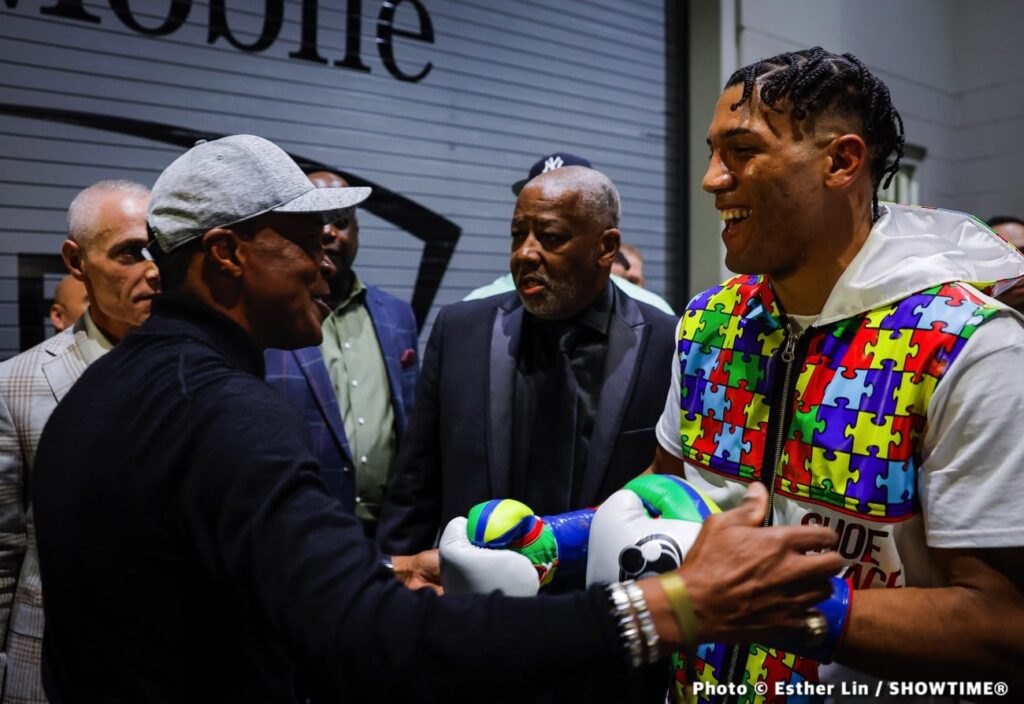Most boxing fans consider “Sugar” Ray Robinson to be the greatest pound-for-pound boxer of all time, and another “Sugar” Ray, Leonard, followed in his footsteps.
The big difference is that Robinson won his first 40 fights before losing to Jake LaMotta (30-5-2 draws), while Leonard only fought 40 fights, mainly due to a detached retina on his return from a 4-2-1 record. He won his first 27 fights before losing to Roberto “Hands of Stone” Duran (71-1), but then beat Duran in the rematch and then again the next time around.
After the loss to LaMotta, Robinson won 91 more fights and went 5-1 against LaMotta, who said, “I fought Sugar Ray so many times that I almost got diabetes.”
Robinson, born Walker Smith Jr., went 85-5 as an amateur with 69 stoppages, 40 of which came in the first round, and won New York AAU and Golden Gloves titles.
Leonard compiled a record of 145 wins and 5 losses, with 75 stoppages. He won gold medals at the 1975 Pan American Games and the 1976 Montreal Olympics, defeating six opponents from Sweden, the Soviet Union, Great Britain, East Germany, Poland and Cuba, all with a 5-0 record.
In December 1946, Robinson (73-1-1) defeated Tommy Bell (39-10-3) at Madison Square Garden to win the NBA World Welterweight Title. In February 1951, Robinson (121-1-2) defeated Jake LaMotta (78-14-3) at Chicago Stadium to win the World Middleweight Title.
Leonard embarrassed Duran in a rematch at the Superdome in New Orleans, Louisiana, stopping Duran in the eighth round to regain the title, then Leonard faced 29-3 Larry Bonds and 36-0 WBA super welterweight champion Ayub Kalule in the ninth round at the Houston Astrodome in Texas.
In Las Vegas, Nevada, Leonard defended his WBC welterweight title against WBA champion Thomas “The Hitman” Hearns. Leonard was behind in the first 13 rounds but rallied to stop Hearns in the 14th round.
With scores of 124-122, 125-121 and 125-122 in favor of Hearns, Leonard needed a knockout to win. The bout was named Fight of the Year by Ring Magazine. Leonard then defeated 28-3-1 Bruce Finch in three rounds in Reno, Nevada.
In May 1982, Leonard was scheduled to defend his title against Roger Stafford and then Aaron “Hawk” Pryor in the fall, but during training Leonard discovered a detached retina in his left eye, which resulted in him announcing his retirement in November.
Leonard returned to the ring in May 1984, defeating 20-4-1 Kevin Howard in the ninth round at the DCU Center in Worcester, Massachusetts, before retiring once again.
Nearly three years later, in April 1987, he moved up to middleweight and challenged WBC champion “Marvelous” Marvin Hagler (62-2) in Las Vegas, Nevada, and upset him by split decision, forcing Hagler to retire from boxing.
Leonard would not fight again until November 1988, when he moved up a weight class to challenge WBC light heavyweight champion Donnie “Golden Boy” Lalonde (31-2), rising from the canvas in the fourth round and stopping Lalonde in the ninth, winning a split decision after eight rounds and also capturing the WBC super middleweight title.
In June 1989, Leonard defended his WBC super middleweight title in a rematch against WBO champion Hearns (46-3) in Las Vegas, Nevada, and won by split decision, with Leonard losing in the fourth and eleventh rounds.
In December, Leonard defeated Duran by a lopsided 85-7 decision in their third bout in Las Vegas, Nevada.
In February 1991, Leonard faced WBC junior middleweight champion “Terrible” Terry Norris (26-3) at Madison Square Garden in New York City. Leonard was knocked down twice and lost by a 12-round unanimous decision.
In his final fight for the IBC middleweight title, Leonard lost to Hector “Macho” Camacho, who had a record of 62 wins, 3 losses and 1 draw, in a five-round bout in Atlantic City, New Jersey. His final record was 36 wins, 3 losses and 1 draw.
Robinson lost his first title defense to Randy Turpin (40-2-1) in London, England in July 1951. He defeated Turpin in a rematch two months later at the Polo Grounds in New York City to recapture the title.
In March 1952, Robinson defeated Carl “Bobo” Olson 48-5 in San Francisco, California, and a month later knocked out Rocky Graziano at Chicago Stadium with a score of 67-8, 6 draws, and 6 losses.
Two months later, Robinson challenged for the world light heavyweight title when he defeated champion Joey Maxim (78-18-4 draws, #173) after 12 rounds at Yankee Stadium in June. The temperature was 104 degrees (forcing a referee change) and Robinson, #157 ½, who was leading 10-3, 9-3-1, 7-3-1, was unable to continue due to heat stroke.
Robinson was never quite the same, and after about two and a half years he returned to the ring in January 1955, scoring a knockout, but losing two weeks later to Ralph “Tiger” Jones (32-12-3).
After four wins, Robinson recaptured the middleweight title with a 71-7 knockout of Carl “Bobo” Olson at Chicago Stadium in December 1955. He lost the title to Gene Fullmer, but won the rematch, then followed it up with the same victory in a rematch against Carmen Basilio.
In January 1960, Robinson suffered consecutive split decision losses to Paul Pender (35-5-2) at the Boston Garden and everyone thought he would never lose again, he drew with an NBA champion, lost to Gene Fullmer (52-4-1) and the rest is history as he ended his career with a decision loss to Joey Archer (44-1) at the Pittsburgh Civic Arena in November 1975, leaving him with a record of 174 wins, 19 losses, 6 draws and 109 stoppages at the age of 44.
Both fighters were inducted into the International Boxing Hall of Fame.

